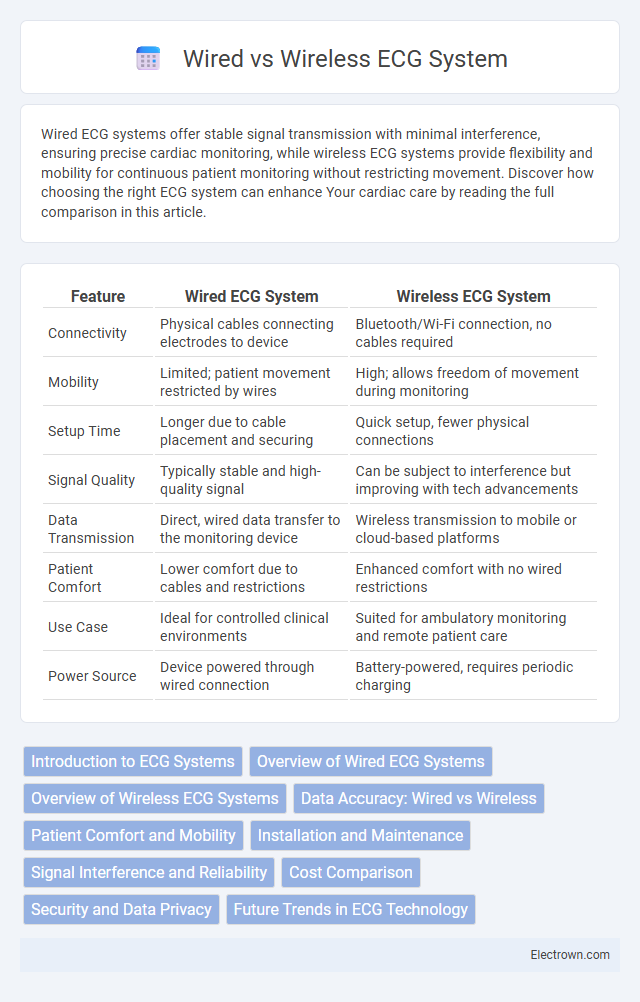Wired ECG systems offer stable signal transmission with minimal interference, ensuring precise cardiac monitoring, while wireless ECG systems provide flexibility and mobility for continuous patient monitoring without restricting movement. Discover how choosing the right ECG system can enhance Your cardiac care by reading the full comparison in this article.
Table of Comparison
| Feature | Wired ECG System | Wireless ECG System |
|---|---|---|
| Connectivity | Physical cables connecting electrodes to device | Bluetooth/Wi-Fi connection, no cables required |
| Mobility | Limited; patient movement restricted by wires | High; allows freedom of movement during monitoring |
| Setup Time | Longer due to cable placement and securing | Quick setup, fewer physical connections |
| Signal Quality | Typically stable and high-quality signal | Can be subject to interference but improving with tech advancements |
| Data Transmission | Direct, wired data transfer to the monitoring device | Wireless transmission to mobile or cloud-based platforms |
| Patient Comfort | Lower comfort due to cables and restrictions | Enhanced comfort with no wired restrictions |
| Use Case | Ideal for controlled clinical environments | Suited for ambulatory monitoring and remote patient care |
| Power Source | Device powered through wired connection | Battery-powered, requires periodic charging |
Introduction to ECG Systems
ECG systems monitor heart activity by detecting electrical signals with either wired or wireless technology. Wired ECG systems provide stable and continuous data transmission via electrodes connected directly to the monitoring device, ensuring high accuracy in clinical settings. Wireless ECG systems offer greater mobility and convenience, allowing you to track cardiac health remotely without restricting movement.
Overview of Wired ECG Systems
Wired ECG systems utilize physical cables to connect electrodes directly to the monitoring device, ensuring stable and high-fidelity signal transmission for accurate cardiac monitoring. These systems are typically preferred in clinical settings for continuous and long-term ECG recording due to their reliable data integrity and minimal signal interference. Common wired ECG configurations include 3-lead, 5-lead, and 12-lead setups, each providing varying levels of diagnostic detail based on the clinical requirement.
Overview of Wireless ECG Systems
Wireless ECG systems utilize advanced Bluetooth or Wi-Fi technology to transmit real-time cardiac data without the constraints of cables, enhancing patient mobility and comfort. These systems integrate compact, lightweight sensors that continuously monitor heart rhythms and send data directly to your smartphone or healthcare provider's platform for immediate analysis. The combination of convenience, remote monitoring capabilities, and data accuracy makes wireless ECG systems ideal for modern cardiac care.
Data Accuracy: Wired vs Wireless
Wired ECG systems generally provide higher data accuracy due to stable connections and minimal interference, ensuring precise cardiac signal transmission. Wireless ECG systems offer greater mobility but may experience occasional signal loss or noise, potentially impacting real-time data fidelity. For critical diagnostics, your choice should consider the balance between data accuracy and convenience.
Patient Comfort and Mobility
Wireless ECG systems significantly enhance patient comfort and mobility by eliminating restrictive cables, allowing patients to move freely during monitoring. These systems reduce skin irritation and discomfort commonly caused by adhesive electrodes attached to wired leads. Wireless ECG technology supports continuous, real-time data transmission, facilitating more natural patient activity and improved diagnostic accuracy in dynamic environments.
Installation and Maintenance
Wired ECG systems require extensive installation with fixed electrodes and cables that demand periodic checking for wear and secure connections. Wireless ECG systems offer simplified installation through wireless sensor patches or wearable devices, reducing setup time and physical constraints. Maintenance for wireless systems centers on battery life management and software updates, whereas wired systems need regular cable integrity checks and potential sensor replacements.
Signal Interference and Reliability
Wired ECG systems offer superior signal reliability with minimal interference due to direct electrode connections, ensuring precise cardiac monitoring. Wireless ECG systems, while providing convenience and mobility, are more susceptible to signal interference from external wireless devices and environmental factors, potentially affecting data accuracy. You should consider your monitoring environment and required signal fidelity when choosing between wired and wireless ECG solutions.
Cost Comparison
Wired ECG systems generally have lower upfront costs due to simpler technology and fewer components, making them more affordable for basic cardiac monitoring needs. Wireless ECG systems involve higher initial investment but offer long-term savings through enhanced mobility, reduced maintenance, and fewer sensor replacements. Your choice should consider both immediate budget constraints and potential efficiency gains over time.
Security and Data Privacy
Wired ECG systems offer enhanced data security by minimizing exposure to wireless hacking risks and interference, ensuring your sensitive health information remains protected within a closed network. Wireless ECG systems, while providing greater mobility and convenience, require robust encryption protocols and secure Bluetooth or Wi-Fi connections to prevent unauthorized access and data breaches. Implementing strict authentication and regular security updates is crucial for maintaining data privacy in wireless ECG monitoring solutions.
Future Trends in ECG Technology
Future trends in ECG technology emphasize the transition from wired to wireless systems, enabling more accurate real-time cardiac monitoring through wearable devices and implantable sensors. Integration of artificial intelligence and machine learning algorithms enhances the predictive analytics capabilities for early detection of arrhythmias and other cardiac anomalies. Advances in miniaturization and battery technology further support continuous, non-invasive patient monitoring, promoting telemedicine and remote healthcare management.
Wired vs Wireless ECG System Infographic

 electrown.com
electrown.com